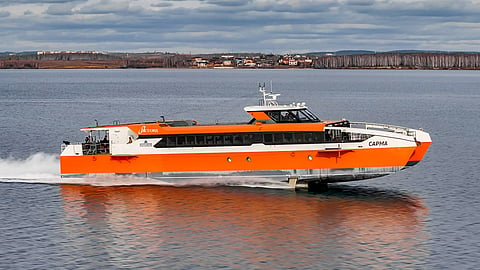VESSEL REVIEW | Sarma – Hydrofoil catamaran ferry for operation on Russia’s Lake Baikal
Russia’s Vympel Shipyard has completed construction of a new catamaran ferry for operation by the East Siberian River Shipping Company. Sarma was built for operation on Lake Baikal, linking the cities of Irkutsk and Severobaykalsk, and was designed by local engineering firm the Sea Tech Group in compliance with Russian River Register rules.
“It was designed in cooperation with Dr Gunther Migeotte in South Africa,” Sea Tech CEO Petr Ezhov told Baird Maritime. “Both parties have extensive experience in designing hydrofoil vessels and the foil system brings together the von Schertel and Alexeyev schools of knowledge on hydrofoil design.”
The ferry has an LOA of 36.7 metres (120 feet), a beam of 11.4 metres (37.4 feet), a draught of only 0.9 metre (three feet), a displacement of 100 tonnes, and space for 148 passengers and four crewmembers. The vessel can reach speeds of up to 35 knots and sail over 1,000 kilometres (620 miles).
Enhanced efficiency for inland navigation
“The vessel was constructed in Rybinsk in blocks which were then transported by road to Irkutsk about 5,000 kilometres (3,100 miles) away for final assembly there,” said Ezhov.
The two fixed hydrofoils located under the keel carry about 70 to 80 per cent of the vessel’s weight, enabling a significant portion of the hull to be lifted out of the water. Only a small portion of the hull remains in contact with the water so that conventional propulsion can be used.
The requirement was for a highly fuel-efficient ferry with high levels of passenger comfort even when operating in Lake Baikal. The vessel needed to be capable of attaining a cruising speed of 30 knots in addition to operating safely in wave heights of up to 1.2 metres (3.9 feet).
The operation of the new ferry would connect a number of shoreline communities with Irkutsk, thus allowing the residents of these communities to easily travel to and from the larger city. It would also help increase tourist traffic, as there are a number of ideal destinations that line Lake Baikal.
Propulsion arrangement using reliable systems in an entirely new layout
Power for the ferry is provided by two diesel engines driving fixed-pitch propellers. The engines can be converted in the future to enable hybrid operation as well as operation on lower-emission fuels such as methanol and LNG.
The vessel’s design permits the use of conventional propulsion even with much of the hull out of the water while the hydrofoils are in operation, whereas earlier hydrofoil-equipped vessel designs required additional modification for such an arrangement to deliver the required performance.
“The hydrofoil system is the largest foil system built in the last 20 years anywhere in the world and is fully classed under Russian River Register rules,” added Ezhov. “There are not many similar reference vessels worldwide and this was the first of this type built in Russia. The hydrodynamics required significant effort to sort out to achieve a suitable balance between calm water efficiency, good seakeeping, and efficient propulsion.”
The ferry also boasts an integrated bridge system, an automated control system, an alarm, and modern navigation equipment to permit day/night operation. A motion control system connected to controllable flaps may also be integrated in the future.
In order to reduce the weight of the onboard cables, a novel CANBUS system is installed to connect the main switchboard and the engine room systems with the main control console in the wheelhouse.
Boarding and disembarkation are done via a telescoping gangway on the bow. The interiors meanwhile offer comfortable accommodation because of the greater onboard space compared to passenger vessels of similar size and capacity.
Design work insights leading to development of new hydrofoil-equipped vessels
In Ezhov’s view, the challenge in designing the ferry lay mainly in maintaining a low draught – around 1.5 metres (4.9 feet) – for the hydrofoils while also achieving the required seakeeping ability. The low draught was viewed as a necessity so that the vessel can safely embark and disembark passengers via unprepared shorelines.
“We also encountered challenges in developing building technology to be distributed between Rybinsk where a large shipbuilding team was in place and Irkutsk where the team was smaller,” he told Baird Maritime. “Therefore, 3D modelling and a proper building strategy became core components in the development of the vessel.”
The work on Sarma also enabled Sea Tech to further develop its hydrodynamic knowledge on building hydrofoil-supported catamarans with fixed foils. Ezhov said the lessons learned from the project are now being applied to new designs for seagoing hydrofoil-assisted catamaran ferries of similar size, the first example of which will be launched in 2025.
Sarma belongs to the Project HSC150B series of ferries. Sister vessel Selenga is currently undergoing sea trials and will soon be handed over to the same operator.


